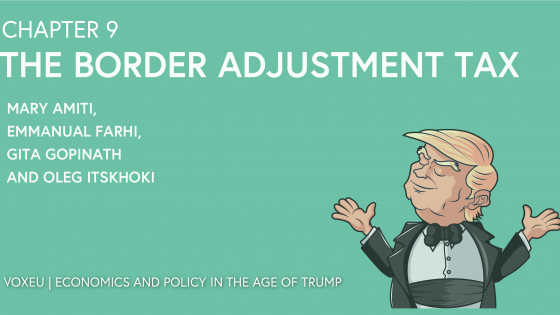Editor's note: This column first appeared as a chapter in the Vox eBook, Economics and policy in the Age of Trump, available to download here.
A key feature of the Trump administration’s economic policy is to slash corporate tax rates from their current 35% rate to 20%, or even as low as 15%. This rate reduction is proposed to be combined with a border adjustment tax, which would make export sales deductible from the corporate tax base, while expenditure on imported goods would not be deductible, in contrast with other costs such as wage bill and purchases of domestic intermediates.1 Therefore, if the border adjustment extends to all imports and exports, it is akin to a combination of a uniform import tariff and an export subsidy on all international trade of the United States.
Why border adjustment?
The border adjustment tax has both an economic and a political rationale. The economic argument in favour of a border adjustment is that it would limit the incentives for profit shifting across countries by means of transfer pricing towards lower tax jurisdictions (Auerbach and Holt-Eakin 2016, Auerbach et al. 2017). The reason for this is that the border adjustment tax is a destination-based tax, linking the tax jurisdiction to the location of consumption, rather than the location of production. The political rationale is that the border adjusment tax is expected to help raise government revenues to cover the deficit that would emerge from the reduction in the corporate tax rate.
Border adjustment neutrality
Under certain circumstances, discussed below, the border adjustment tax has no effects on economic outcomes, in which case we call it neutral. A classical result in the field of international trade, called Lerner (1936) symmetry, is that a uniform tariff on all imports is equivalent to a uniform tax of the same magnitude on all exports.2 As a corollary of Lerner symmetry, a combination of a uniform import tariff and an export subsidy of the same magnitude must be neutral, having no effect on imports, exports and other economic outcomes (see Grossman 1980). This policy shift results in an increase in the home relative wage and domestic cost of production by the amount of the tariff. As a result, the relative cost of domestic production increases proportionally with the cost of imports, as well as with the subsidy to exports, leaving no relative price affected, nor the real wage. The amount of trade, production and consumption also remains unchanged. As a result, tax policies that feature a border adjustment, such as the value added tax (VAT), do not have to systematically promote or demote trade (see Feldstein and Krugman 1990). The US policy proposal is to include the border adjustment tax together with a corporate income tax, which is a less common policy option, but the neutrality of border adjustment applies to it in equal measure.
Conditions for neutrality
The discussion above suggests that a necessary condition for neutrality is that the relative wage rates across countries can flexibly respond to policy. To the extent that wages are sticky, the relative wage adjustment cannot happen via changes in nominal wages. However, this adjustment can be intermediated by a nominal exchange rate appreciation of the magnitude of the border adjustment tax.3 Indeed, such an exchange rate appreciation ensures that border adjustment taxes do not affect the relative prices of traded and locally produced goods – the appreciation cancels out the stimulating effect of the tax deduction on exports, as well as the import levy effect of the border adjustment. Nevertheless, a number of additional conditions must be satisfied for the neutrality to hold (Barbeiro et al. 2017):
- While wages can be sticky in arbitrary ways, the neutrality requires that either trade prices are flexible (i.e., immediately adjust to the tax), or that a certain symmetry assumption on the pass-through of the tax and exchange rate appreciation is satisfied. In particular, the neutrality must be supported by a reduction in the dollar prices of both US exports and imports in order to keep unchanged the terms of trade of the US with the rest of the world in the face of the dollar appreciation. While this is a natural outcome when prices are flexible,4 the short-run price stickiness may result in the violation of this assumption, distorting trade prices and, in consequence, trade flows.
- The border adjustment tax should extend uniformly to all imports and exports, otherwise it results in a differential trade distortion for certain goods and/or trading firms. When the border adjustment tax is uniform, then indeed the policy should not be viewed as a trade policy.
- The US gross foreign assets and liabilities should be entirely in foreign currency terms, otherwise the exchange rate appreciation associated with the border adjustment tax will result in an international transfer between the US and the rest of the world by means of a capital gain or loss on the external asset positions. The dollar appreciation may have additional distributional consequences within the country, but the macroeconomic outcome of the border adjustment tax can still be neutral in this case.
- The policy change must be unexpected, one-time and permanent. Otherwise, the dollar will appreciate, at least in part, in expectation before the policy is implemented, resulting in both distortions to international trade and to the portfolio choices of private agents. Similarly, neutrality would not hold if the policy is not expected to be permanently in place, or if the other countries are expected to retaliate with their own policies in the future.
- Lastly, the border adjustment policy and the ensuing appreciation should not result in any changes to the monetary policy stance. Indeed, if neutral, the policy should not affect the output gaps or the effective consumer price levels (even while reducing the trade prices in dollar terms). Therefore, monetary authorities that follow conventional Taylor rules should not want to adjust the rates in response to this fiscal policy change. If, however, monetary authorities also factor in the exchange rate movements in their decisions, and do not want to allow for large swings in the value of the dollar, they may respond, violating the condition for neutrality.
Clearly, the five conditions for neutrality stated above are not innocuous, and are likely to fail in reality. Below we discuss what may happen under different scenarios.
Fiscal revenues
Consider for now that the conditions for neutrality are satisfied and that the dollar appreciates by the full amount needed to keep the relative trade prices and trade flows unchanged. This would result in no macroeconomic consequences from the border adjustment tax, apart from one. As we show in Barbeiro et al.(2017), this policy indeed results in an undistortive (lump-sum) transfer from the US private sector to the government budget in proportion with the trade deficit of the US. This may be viewed as the magic of the border adjustment tax. How does it happen? To understand the mechanism, consider a hypothetical case in which the US household sector holds net foreign assets (NFA) against the rest of the world in foreign currency to support a permanent trade deficit. This does not violate the neutrality assumptions. Then the dollar appreciation induced by the border adjustment will result in a capital loss for the US household sector – their foreign currency NFA have less purchasing power in the US market with unchanged consumer price level in dollars. At the same time, the purchasing power of the US economy, as a whole, from the rest of the world does not change, as the import prices in foreign currency stay the same. This gap in valuations goes to the US government, which introduces a wedge between the border price paid to the foreigners and the domestic price paid by the US consumers. Effectively, this lump-sum transfer from domestic households to the government is a capital levy on their stock of NFA in the face of an unanticipated dollar appreciation.
This levy is transferred to the government in flow terms, as the US households convert their stock of NFA into a flow of trade deficits.5
This analysis has a number of implications. First, while the fiscal revenues are positive in periods of trade deficits, they are negative in periods of trade surpluses, exactly in proportion to the size of the trade imbalance. Second, in order for the intertemporal budget constraint of the US to be satisfied, the net present value of trade deficits must be equal to the initial net foreign asset position. Since the US has currently a negative net foreign asset position, the US must run a cumulative trade surplus in the future. This means that the overall transfer would be away from the government budget and towards the private sector, so the policy would reduce the government revenues over the long run (Blanchard and Furman 2017, Kamin and Setser 2017).
International transfer
Under neutrality, the border adjustment tax involves no international transfers – neither towards, nor away from the US. This, however, is no longer the case when some of the gross international assets or liabilities are in the home currency (the dollar), violating one of the conditions for neutrality. This is due to the capital gain against the rest of the world on the dollar asset holdings resulting from a dollar appreciation. Since for the United States, the foreign assets are mostly in foreign currency, while foreign liabilities are almost entirely in dollars, this would generate a massive transfer to the rest of the world and a capital loss for the US of the order of magnitude of 10% of the US annual GDP or more.6 This capital loss would reduce the purchasing power of the US in terms of the foreign goods.
Long-run departures from neutrality
An essential requirement for the border adjustment neutrality is that the tax extends uniformly to all imports, while the subsidy extends uniformly to all exports. This condition is likely to fail in practice. First, it would fail for a number of service sectors, such as tourism and education, which serve foreigners inside the US. These sectors would be squeezed by a dollar appreciation, which would not be offset by the export subsidy (Veuger 2017).
Perhaps more importantly, there is a likely departure from uniform taxation of imports, if the border adjustment tax is introduced as a part of the corporate tax. In the US, a considerable share of employment and production is done by S-corps, which in contrast to C-corps, are not subject to the corporate tax, but instead subject to the personal income tax of the owners. The proposed policy would create incentives for imports to be brought into the US by the S-corps in a non-taxable way, resulting in the border adjustment tax not applying to a sizeable portion of the US imports.
Short-run departures from neutrality
One of the key requirements for the neutrality of the border adjustment tax in the short run, when prices are inflexible, is that the tax together with the dollar appreciation would immediately bring down the dollar border prices paid by and charged to foreigners. If this does not hold, the prices of the traded goods would increase relative to the domestically produced goods, both in the US and in the rest of the world, discouraging both imports to and exports from the US. The empirical pattern of the US trade is that of dollar currency pricing for both imports and exports (see Gopinath et al. 2010). That is, the majority of the contracts governing US import and export flows are preset in US dollars and adjusted infrequently, about once a year. Unless these terms are renegotiated fast after the policy is in place, the relative cost of imported inputs would go up in the US because of the effective import tax associated with border adjustment and given the unchanged dollar import prices. More expensive imports will translate into higher consumer prices in the US. Exports will also become more expensive relative to foreign-produced goods because of the dollar appreciation. The US exporters will benefit from greater profit margins in view of the export subsidy associated with the border adjustment, but they are also likely to lose export market shares from the dollar appreciation, before they reduce their dollar prices.7
Therefore, US exports are unlikely to increase in response to border adjustment tax, and instead will likely fall together with US imports in the short run, with no clear effect on the trade balance. As trade prices adjust over time, both imports and exports will recover, resulting in a neutral long-run effect of the border adjustment tax on trade.8
Retaliation
Lastly, we address the issue of retaliation by foreign countries. There are two types of retaliation: (i) a tariff war or a WTO litigation; and (ii) a monetary policy response in the rest of the world. We focus here on the second type of response.9 A large dollar appreciation may pose a threat to the banking system in multiple countries, where banks have significant dollar-denominated liabilities and foreign currency assets. Under these circumstances, the monetary authorities in these countries will be under pressure to limit the size of the devaluation of the of their currency against the dollar (see Rey 2013). If they act to raise interest rates to limit the dollar appreciation, this will result in a departure from the neutrality of the border adjustment policy, and moreover in a likely global economic slowdown due to the tightened monetary policy stance.
Author’s note: The views expressed in this article are those of the authors and do not necessarily reflect the position of the Federal Reserve Bank of New York or the Federal Reserve System. Any errors or omissions are the responsibility of the authors.
References
Amiti, M., O. Itskhoki and J. Konings (2017), “Why the Proposed Border Tax Adjustment Is Unlikely to Promote U.S. Exports,”, FRSBNY: Liberty Street Economics.
Auerbach, A. J., M. P. Devereux, M. Keen, and J. Vella (2017), “Destination-Based Cash Flow Taxation”, Oxford University Centre for Business Taxation Working Paper 17/01.
Auerbach, A.J. and D. Holtz-Eakin (2016), “The Role of Border Adjustments in International Taxation”, American Action Forum.
Barbeiro, O., E. Farhi, G. Gopinath, and O. Itskhoki (2017), “The Economics of Border Adjustment Tax”, (available at: http://scholar.princeton.edu/itskhoki/).
Blanchard, O. and J. Furman (2017), “Who Pays for Border Adjustment? Sooner or Later, Americans Do”, Trade and Investment Policy Watch, PIE.
Bown, C.P. (2017), “Will the Proposed US Border Tax Provoke WTO Retaliation from Trading Partners?”, Policy Brief: PIE.
Casas, C., F. J. Diez, G. Gopinath, and P.-O. Gourinchas (2017), “Dominant Currency Paradigm: A New Model for Small Open Economies”, (available: https://scholar. harvard.edu/gopinath/).
Farhi, E., G. Gopinath, and O. Itskhoki (2014), “Fiscal Devaluations”, Review of Economics Studies, 81(2), 725–760.
Farhi, E., G. Gopinath and O. Itskhoki (2017), “Trump’s Tax Plan and the Dollar.”, Project Syndicate.
Feldstein, M. S., and P. R. Krugman (1990), “International Trade Effects of Value- Added Taxation”, in Taxation in the Global Economy, pp. 263–282, National Bureau of Economic Research, Inc.
Gopinath, G., O. Itskhoki, and R. Rigobon (2010), “Currency Choice and Exchange Rate Pass- through”, American Economic Review, 100(1), 304–336.
Grossman, G. M. (1980), “Border tax adjustments: Do they distort trade?”, Journal of International Economics, 10(1), 117–128.
Kamin, D. and B. Setser (2017), “Just How Much Money Should the Border-Adjusted Tax Raise Be Expected To Raise?”, Council on Foreign Relations: Follow the Money.
Lerner, A. P. (1936), “The Symmetry Between Import and Export Taxes”, Economica, 3, 306–313.
Rey, H. (2013), “Dilemma not trilemma: the global cycle and monetary policy independence”, Jackson Hole Economic Policy Symposium Proceedings.
Ryan, P. (2016), “A Better Way: Our vision for a confident America”, (available at: https://abetterway.speaker.gov/_assets/pdf/ABetterWay-Tax-PolicyPaper.pdf).
Veuger, S. (2017), “How border adjustment threatens the education, real estate, and hospitality industries”, AEIdeas.
Endnotes
[1] The other features of the Ryan-Trump tax plan include streamlining the corporate tax system, allowing for immediate expensing of capital investment when it occurs and eliminating the current interest deduction. See Paul Ryan’s policy proposal “A Better Way” (in particular, pp. 27-28 on border adjustment tax).
[2] A uniform tariff on imports reduces imports, but trade balance requires a parallel reduction in exports, which in equilibrium would result from the increase in the relative home wage and hence the relative cost of home production. The same effects of reducing exports and imports would emerge from an export tax, which however would be supported by a reduction in the relative home wage.
[3] In economies with a fixed nominal exchange rate, such as members of a currency union, a border adjustment tax has the same effect as a nominal devaluation, and is often referred to as a fiscal devaluation (see Farhi, Gopinath, and Itskhoki 2014). This policy option was popular among the Euro Zone members in the aftermath of the financial crisis of 2008-09.
[4] Indeed, as prices become flexible, the border adjustment gives the US exporters an incentive to reduce the dollar export prices, while dollar appreciation gives the incentive for the reduction of the import prices charged by the suppliers to the US.
[5] Under the further assumption of Ricardian equivalence, this distributional shift from households to the government budget has no macroeconomic consequences, and neutrality is maintained. Nonetheless, the private wealth of the holders of the foreign currency assets will be reduced in proportion with the dollar appreciation.
[6] We make this calculation in Farhi et al. (2017).
[7] We discuss these mechanisms further in Amiti et al. (2017). In case where the dollar appreciation is small relative to the border adjustment tax, the US exports may increase in the medium run, as dollar prices start to fall in response to the tax. In simulations in Barbeiro et al. (2017), we find however that a large dollar appreciation is still a likely scenario, even in cases when the exact neutrality of the border adjustment tax does not hold.
[8] More generally, to the extent that the dollar plays the central role in international trade contracting, a dollar appreciation will result in a negative shock to global trade, akin to a temporary tariff on all international trade flows, before the dollar prices adjust downwards (Casas et al. 2017).
[9] For the discussion of trade retaliation, see Bown (2017).






